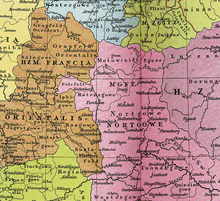Heinrich von Schweinfurt
Heinrich von Schweinfurt (* before 980; † September 18, 1017 ) was Margrave of Schweinfurt .
Life
Heinrich, also called "Hezilo" and "Ez (z) ilo", was the son of Margrave Berthold , Count of Eastern Franconia, and Eilika, née von Walbeck , founder of the Benedictine monastery in Schweinfurt . In 981 he became count on the lower Naab , 983 count on the lower Altmühl , 994 margrave on the Bavarian Nordgau and 1002 count in the Radenzgau .
In 995, Ezzilo pointed out that "Ezzelenkirchen" (Etzelskirchen, see Höchstadt an der Aisch ) was named after him (the Counts of Schweinfurt also had property in the Riedfeld around Neustadt an der Aisch , for example in Gutenstetten ).
In 1002, Heinrich supported Duke Heinrich IV of Bavaria in the election of a king against Margrave Ekkehard I of Meißen and Duke Hermann II of Swabia with the promise of being able to succeed Heinrich in Bavaria. When the new king did not honor his promise, Heinrich von Schweinfurt allied himself in the Schweinfurt feud with some relatives and Boleslaw Chrobry , the Duke of Poland , who had fallen out with Heinrich II, and Bruno , the king's brother.
The power base of the so-called Margraves of Schweinfurt was based on extensive county rights in Nordgau, Radenzgau and Volkfeldgau , whose power-political backbone was, among other things, an extensive castle system. The fighting, handed down by the contemporary reporter Thietmar von Merseburg , affected the castles Ammerthal , Creußen , Kronach and Schweinfurt , among others .
The uprising was unsuccessful militarily. Heinrich II gave the ducal dignity in Bavaria to Heinrich von Luxemburg , his brother-in-law, and thus strengthened the royal power in Eastern Franconia. Whether Count Heinrich lost all county rights and imperial fiefs is controversial. After his imprisonment at Giebichenstein Castle , he was pardoned in 1004 and probably received a large part of his property, including his own , back from Heinrich II.
Before 1017 a Heinrich can be proven as a count on the Pegnitz , in 1015 as a count on the upper Naab. Heinrich von Schweinfurt died on September 18, 1017. He was buried by the Würzburg bishop Heinrich, the first Bamberg bishop Eberhard and the Trieste bishop Richulf (also Rikulf) on the north side of the church of Schweinfurt Castle.
Family and descendants of Heinrich
Before 1009 he married Gerberga († after 1036), daughter of Otto von Henneberg (Count in Grabfeld ) or Count Heribert in Kinziggau ( Konradiner ). He had several children with her, including four known by name:
- Otto von Schweinfurt , † September 28, 1057, from 1048 Duke of Swabia ; ⚭ 1036 Irmingard, † 1078 before April 29, daughter of Margrave Ulrich Manfred von Turin and Berta degli Obertenghi , who married Count Ekbert I of Braunschweig , Margrave of Meißen († January 11, 1068) ( Brunonen ) in 1058
- Eilika, † December 10 after 1055–1056, ⚭ Bernhard II Duke in Saxony , † June 29, 1059 ( Billunger )
- Judith , † August 2, 1058; ⚭ 1) after 1021 Břetislav I Duke of Bohemia , † January 10, 1055 ( Przemyslids ); ⚭ 2) April 1055 Peter King of Hungary , † August 30, 1046 ( Arpaden )
- Burchard , Bishop of Halberstadt
Presumably he had another son, Heinrich, who is attested from 1021-1043 as Count on the Pegnitz and 1043 as Count on the upper Naab, and who is believed to be the progenitor of the Counts of Lechsgemünd , Horburg and Graisbach .
literature
- Peter Kolb, Ernst-Günter Krenig (Hrsg.): Lower Franconian history. Volume 1: From the Germanic conquest to the high Middle Ages. Echter, Würzburg 1989, ISBN 3-429-01263-5 , pp. 221-223.
Individual evidence
- ^ Max Döllner : History of the development of the city of Neustadt an der Aisch up to 1933. Ph. C. W. Schmidt, Neustadt a. d. Aisch 1950, OCLC 42823280 ; New edition to mark the 150th anniversary of the Ph. C. W. Schmidt publishing house, Neustadt an der Aisch 1828–1978. Ibid 1978, ISBN 3-87707-013-2 , p. 139.
| personal data | |
|---|---|
| SURNAME | Heinrich von Schweinfurt |
| ALTERNATIVE NAMES | Hezilo |
| BRIEF DESCRIPTION | Margrave of Schweinfurt |
| DATE OF BIRTH | before 980 |
| DATE OF DEATH | September 18, 1017 |
